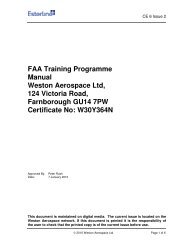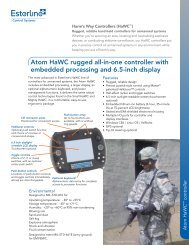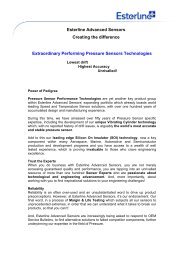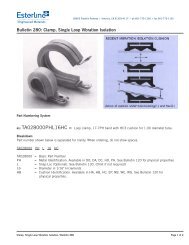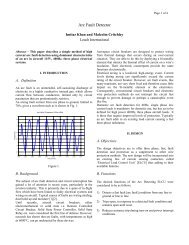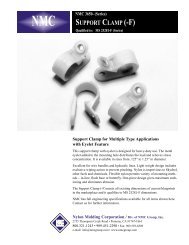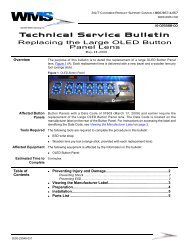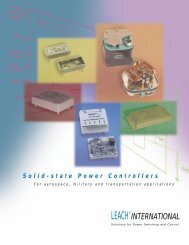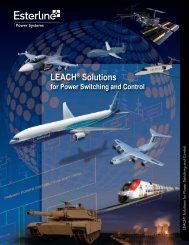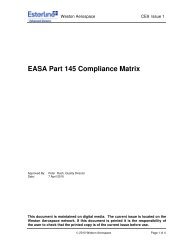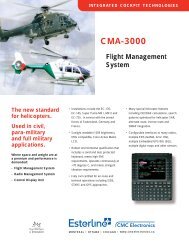Future GNSS Receivers - Esterline
Future GNSS Receivers - Esterline
Future GNSS Receivers - Esterline
You also want an ePaper? Increase the reach of your titles
YUMPU automatically turns print PDFs into web optimized ePapers that Google loves.
AEEC 2013 Presentation to the<br />
Airlines and the Aviation Industry<br />
Multi-Frequency/Multi-Constellation<br />
(MFMC) <strong>GNSS</strong> <strong>Receivers</strong><br />
Value for Aviation and Airlines<br />
John Studenny – CMC GPS Product Manager<br />
Alain Beaulieu – CMC Program Manager – GPS and LPV/GLS Programs<br />
Michel Gonthier – CMC GPS System Engineer<br />
Rex Hygate – CMC Marketing and Sales Manager<br />
This proprietary document and all information contained therein is the property of <strong>Esterline</strong> CMC Electronics (CMC), its divisions and subsidiaries.<br />
It may not be used, copied, reproduced or otherwise dealt with, nor may its contents be communicated to others in whole or in part, without the<br />
express written consent of CMC. It may not be used directly or indirectly for purposes other than those expressly granted in writing by CMC.
Agenda<br />
• Introduction… What airlines see as value<br />
• GPS, SBAS, GBAS… What we have today<br />
• Brief Overview of Today’s Technology<br />
• <strong>Future</strong> Airline Business Needs<br />
• Current and <strong>Future</strong> Mandates<br />
• <strong>Future</strong> <strong>GNSS</strong> and Their Signals<br />
• <strong>Future</strong> <strong>GNSS</strong> <strong>Receivers</strong><br />
• MCMF Receiver Technology and Complexity<br />
Title: <strong>Esterline</strong> CMC Electronics<br />
MCMF <strong>GNSS</strong> <strong>Receivers</strong><br />
Value for Aviaiton and the Airlines<br />
<strong>Esterline</strong> CMC Electronics – Proprietary Data 1
Introduction<br />
• Avionics: what value proposition to the Airlines<br />
– Will new avionics reduce operating costs<br />
• Operation costs – fuel consumption<br />
– Support more efficient (RNP) routes<br />
– LPV & GLS approaches (no delays)<br />
• Single type of equipage used globally<br />
• Minimize training costs<br />
– Will avionics support new mandates<br />
• ADS-B mandates (2020 or earlier)<br />
• GLONASS mandates (2017)<br />
• Reducing use of ILS is a possible mandate<br />
• Any future state-imposed <strong>GNSS</strong> mandate<br />
• Jamming and spoofing detection mandates<br />
– Will avionics enable business expansion<br />
• RNP, LPV, and GLS operations may open<br />
new routes and destinations,<br />
may increase passenger traffic (= new revenue).<br />
Acquisition of (new) avionics justified when the business benefits.<br />
Title: <strong>Esterline</strong> CMC Electronics<br />
MCMF <strong>GNSS</strong> <strong>Receivers</strong><br />
Value for Aviaiton and the Airlines<br />
<strong>Esterline</strong> CMC Electronics – Proprietary Data 2
GPS, SBAS, GBAS & GLONASS: What’s available today<br />
GPS SBAS GBAS GLONASS<br />
COST REDUCTION<br />
“on-schedule” SIDS & STARS<br />
Support RNP & more efficient routes<br />
CURRENT MANDATES<br />
ADS-B<br />
GLONASS<br />
Support New Destinations/Business<br />
Terminal Area support<br />
(availability>99.999%)<br />
Non-Precision Appr (availability>99.999%)<br />
CAT – I<br />
SA-AWARE<br />
0.3 0.1<br />
0.3<br />
CAT II/III<br />
expected<br />
Title: <strong>Esterline</strong> CMC Electronics<br />
MCMF <strong>GNSS</strong> <strong>Receivers</strong><br />
Value for Aviaiton and the Airlines<br />
<strong>Esterline</strong> CMC Electronics – Proprietary Data 3
GPS, SBAS, GBAS… What we have today (cont.)<br />
Technology that CAN be used by Airlines TODAY:<br />
• GPS<br />
– Basic Navigation, RNP0.11 (best case) with INS integration<br />
• SBAS<br />
– Provide RNP support up to RNP 0.1, INS not required<br />
– Provide LPV approaches up to CAT-I equivalent<br />
• GBAS<br />
– Provide GLS approaches up to CAT-I equivalent today<br />
CAT-II/III is being worked and is expected around 2017<br />
• GLONASS<br />
– Similar to GPS, can be augmented by SBAS (SDCM) and GBAS CAT-I<br />
– Certification basis developed by Russia;<br />
can certify GLONASS as a NON-TSO function in North America.<br />
– Mandated for installation in Russian registered aircraft,<br />
but not explicit on how/when to use GLONASS in flight.<br />
Today’s technology appears to satisfy most airline business needs<br />
Title: <strong>Esterline</strong> CMC Electronics<br />
MCMF <strong>GNSS</strong> <strong>Receivers</strong><br />
Value for Aviaiton and the Airlines<br />
<strong>Esterline</strong> CMC Electronics – Proprietary Data 4
GPS, SBAS, GBAS… Equipage Status Today<br />
• GPS, SBAS, and GBAS Deployment on Airliners<br />
– GPS installed in most commercial passenger aircraft.<br />
Factor for change: better (more efficient) airspace use, safety,<br />
the de-facto world <strong>GNSS</strong> standard today.<br />
– SBAS not accepted by air transport in general, LP/LPV even less so.<br />
Resistance to equip with SBAS continues.<br />
Factors for change: ADS-B compliance, no new ILS deployments & aging ILS<br />
replaced with LPV approaches, more stringent Missed Approach requirements,<br />
better RNP routes and airspace, WGS-84 height source (EGPWS & TAWS), safety,<br />
on its way to becoming a de-facto <strong>GNSS</strong> CAT-I world standard.<br />
– GBAS not asked for by commercial air transport in general. ILS heavily used.<br />
Factors for change: approved certification basis as CAT-II/III solution & Government<br />
acquisition of ground stations, aging ILSs replaced with GBAS,<br />
GBAS as a possible CAT-I solution where SBAS LPV coverage not provided (until<br />
SBAS catches up with coverage),<br />
not a de-facto CAT-I/II/III world standard until a major GBAS deployment happens.<br />
– GLONASS<br />
Factor: mandates imposed on Russian registered aircraft in Russia only,<br />
not a de-facto world standard, appears confined to Russia.<br />
Title: <strong>Esterline</strong> CMC Electronics<br />
MCMF <strong>GNSS</strong> <strong>Receivers</strong><br />
Value for Aviaiton and the Airlines<br />
<strong>Esterline</strong> CMC Electronics – Proprietary Data 5
Brief Overview of Today’s Technology<br />
• GPS<br />
– Lots of SA-ON hardware still flying.<br />
– SA-OFF recently introduced<br />
– Issues:<br />
• lacks sufficient INTEGRITY (high traffic ADS-B, RNP),<br />
supplemented with integrated IRS solution (expensive)<br />
• will not support precision approach unless augmented<br />
– Positive: stable and proven operation over decades<br />
• SBAS<br />
– is a GPS augmentation, capability to support <strong>GNSS</strong><br />
– provides INTEGRITY (Primary Mission) and<br />
DIFFERENTIAL CORRECTIONS (for LP & LPV)<br />
– superb accuracy & integrity in entire coverage area<br />
– supports CAT-I precision approaches WITHOUT any<br />
reliance on airport infrastructure investments –<br />
it’s all in the avionics<br />
– not expected to support CAT-II/III ever (even with L1+L5)<br />
Single frequency<br />
‘GPS L1’<br />
Title: <strong>Esterline</strong> CMC Electronics<br />
MCMF <strong>GNSS</strong> <strong>Receivers</strong><br />
Value for Aviaiton and the Airlines<br />
<strong>Esterline</strong> CMC Electronics – Proprietary Data 6
Brief Overview of Today’s Technology (cont.)<br />
• GBAS<br />
– Is a GPS augmentation system but unlike SBAS, requires<br />
the use of a VHF Data Broadcast (VDB) uplink signal<br />
from ground station to avionics.<br />
– VDB signal occupies localizer band (108-118 MHz).<br />
Issues:<br />
• What antenna will be used as a VDB antenna<br />
• VDB avionics system performance considered to be very<br />
stringent<br />
– Very, very few GBAS ground stations, unlikely to change.<br />
GPS L1<br />
and VDB<br />
– Currently, GBAS certification supports CAT-I ONLY<br />
– Work underway to support GBAS CAT-II/III;<br />
Issue is insufficient INTEGRITY<br />
(ionosphere refuses to cooperate…).<br />
GBAS CAT-II/III Certification with L1 only<br />
will be done with 9X% availability, the “X” is TBD…<br />
Title: <strong>Esterline</strong> CMC Electronics<br />
MCMF <strong>GNSS</strong> <strong>Receivers</strong><br />
Value for Aviaiton and the Airlines<br />
<strong>Esterline</strong> CMC Electronics – Proprietary Data 7
This could be<br />
alleviated with<br />
today’s<br />
technology<br />
Commercial Aviation <strong>Future</strong> Business Needs<br />
• Must fly and save/make money:<br />
Cost side:<br />
• Lower cost of equipment acquisition & ownership<br />
• Lower training costs<br />
• A global “all-in” GPS receiver (GPS/SBAS/GBAS/etc…)<br />
• Better and more efficient routes/air space, reduce fuel cost<br />
• Guaranteed time of departure and arrival – meet schedule &<br />
reduce delays, costs of delays<br />
– What new costs are coming:<br />
• Mandates can impact business & force an artificial business<br />
case: No mandated equipage = No authorisation to fly<br />
Impact:<br />
– Forced equipage to meet mandate<br />
– Marginal (cost) performance improvement<br />
Title: <strong>Esterline</strong> CMC Electronics<br />
MCMF <strong>GNSS</strong> <strong>Receivers</strong><br />
Value for Aviaiton and the Airlines<br />
<strong>Esterline</strong> CMC Electronics – Proprietary Data 8
Current and <strong>Future</strong> Mandates<br />
• Current Mandate: GLONASS<br />
– Russian Government requires use of GLONASS<br />
for Russian registered aircraft.<br />
– SDCM is the Russian equivalent of WAAS,<br />
supports GPS, GLONASS, in future GALILEO<br />
– Mandate unclear concerning GLONASS use in flight deck<br />
• Possible fallout mandates for <strong>GNSS</strong> equipage<br />
– GALILEO mandate in Europe<br />
– BEIDOU-2 mandate in China<br />
– Other nation states<br />
– Concerns:<br />
• Liability, who pays in case of incident<br />
• Enforcement, when/how to use in the flight deck<br />
• Certification Standards (ICAO) Processes<br />
• Cost Real & tangible benefits<br />
Title: <strong>Esterline</strong> CMC Electronics<br />
MCMF <strong>GNSS</strong> <strong>Receivers</strong><br />
Value for Aviaiton and the Airlines<br />
<strong>Esterline</strong> CMC Electronics – Proprietary Data 9
<strong>Future</strong> <strong>GNSS</strong> and Their Signals<br />
• Compatibility among new <strong>GNSS</strong> (with as GPS baseline)<br />
GPS<br />
SBAS<br />
GALILEO<br />
GLONASS<br />
BEIDOU-2<br />
Dual Freq<br />
‘L1 – L5’<br />
Dual Freq<br />
‘NEAR<br />
L1 – L5’<br />
FDMA<br />
Title: <strong>Esterline</strong> CMC Electronics<br />
MCMF <strong>GNSS</strong> <strong>Receivers</strong><br />
Value for Aviaiton and the Airlines<br />
<strong>Esterline</strong> CMC Electronics – Proprietary Data 10
Today’s <strong>GNSS</strong> Signal Spectrum<br />
ARNS<br />
ARNS<br />
E5/L5 Band L2 Band E6 Band E1/L1 Band<br />
FDMA<br />
Title: <strong>Esterline</strong> CMC Electronics<br />
MCMF <strong>GNSS</strong> <strong>Receivers</strong><br />
Value for Aviaiton and the Airlines<br />
<strong>Esterline</strong> CMC Electronics – Proprietary Data 11
<strong>Future</strong> <strong>GNSS</strong> Signal Spectrum<br />
ARNS<br />
ARNS<br />
E5/L5 Band L2 Band E6 Band E1/L1 Band<br />
FDMA<br />
Proposed<br />
CDMA<br />
Title: <strong>Esterline</strong> CMC Electronics<br />
MCMF <strong>GNSS</strong> <strong>Receivers</strong><br />
Value for Aviaiton and the Airlines<br />
<strong>Esterline</strong> CMC Electronics – Proprietary Data 12
<strong>Future</strong> <strong>GNSS</strong> <strong>Receivers</strong><br />
Benefits of<br />
Dual Frequency <strong>Receivers</strong>:<br />
Measure and eliminate ionospheric induced errors<br />
– Fewer SBAS remote integrity monitor stations (RIMS) needed<br />
(since ionospheric induced errors can be measured by dual<br />
frequency receivers, do not need to monitor/model ionosphere).<br />
– INTEGRITY improvement: CAT-I performance world wide with<br />
significantly reduced number of RIMS because ionosphere<br />
ceases to be a problem.<br />
– GBAS CAT II/III performance and INTEGRITY is ASSURED<br />
because ionosphere ceases to be a problem.<br />
Dual Frequency receivers can provide a significant improvement in<br />
air transport capability and lower national infrastructure cost<br />
Title: <strong>Esterline</strong> CMC Electronics<br />
MCMF <strong>GNSS</strong> <strong>Receivers</strong><br />
Value for Aviaiton and the Airlines<br />
<strong>Esterline</strong> CMC Electronics – Proprietary Data 13
<strong>Future</strong> <strong>GNSS</strong> <strong>Receivers</strong> (cont.)<br />
Issues concerning<br />
Dual Frequency <strong>Receivers</strong>:<br />
Too many frequency bands<br />
– Situation: L1 + L5 + FDMA exist today. Antennas: one L1 + L5 antenna,<br />
one FDMA antenna. Combined wideband and meet aviation RFI<br />
requirements not possible – cross-band RF pollution is very likely.<br />
– Single antennas for L1 + L5 and “near” L1 + “near” L5 and FDMA<br />
are UNLIKELY due to interference requirements.<br />
– “Near” L1 & L5 are too many bands for benefit to Commercial Aviation.<br />
– Multi-antenna aircraft installation is a problem, issues: placement, EMI,<br />
radiation patterns, etc… STCs may become challenged.<br />
One L1+L5 dual frequency band recommended. Encourage a L1 + L5 standard.<br />
If we Coexist with legacy FDMA then 2 antennas likely.<br />
Title: <strong>Esterline</strong> CMC Electronics<br />
MCMF <strong>GNSS</strong> <strong>Receivers</strong><br />
Value for Aviaiton and the Airlines<br />
<strong>Esterline</strong> CMC Electronics – Proprietary Data 14
<strong>Future</strong> <strong>GNSS</strong> <strong>Receivers</strong> (cont.)<br />
Benefits of<br />
Multi-Constellation <strong>Receivers</strong>:<br />
More measurements, constellation independence<br />
– Fallback modes – when one constellation fails, another awaits.<br />
– National independence for each state with its own <strong>GNSS</strong><br />
– Possible INTEGRITY improvement . Not clear if ultimately<br />
beneficial in the flight deck.<br />
– Possibly improved spoofing resilience.<br />
– Satisfy future mandate requirements.<br />
Constellation and national <strong>GNSS</strong> independence<br />
can be strong drivers behind mandates.<br />
Title: <strong>Esterline</strong> CMC Electronics<br />
MCMF <strong>GNSS</strong> <strong>Receivers</strong><br />
Value for Aviaiton and the Airlines<br />
<strong>Esterline</strong> CMC Electronics – Proprietary Data 15
<strong>Future</strong> <strong>GNSS</strong> <strong>Receivers</strong> (cont.)<br />
Issues concerning<br />
Multi-Constellation <strong>Receivers</strong>:<br />
Complex. Expensive. Potentially many antennas.<br />
– International standards development (ICAO) meeting place is<br />
essential.<br />
– Certification treaties highly recommended =><br />
recognition of one state’s certification by another.<br />
– No international agreement on how to protect navigation bands<br />
and deal with jammers and spoofers (law-making).<br />
– The rules: when & where to use what <strong>GNSS</strong> and how.<br />
Cost. Complexity. Certification. Mandates.<br />
Lots of questions, no answers.<br />
Title: <strong>Esterline</strong> CMC Electronics<br />
MCMF <strong>GNSS</strong> <strong>Receivers</strong><br />
Value for Aviaiton and the Airlines<br />
<strong>Esterline</strong> CMC Electronics – Proprietary Data 16
MCMF <strong>Receivers</strong> - The <strong>Future</strong> Today<br />
Standards, Certification, Timelines.<br />
– RTCA: L1 + L5 Antenna MOPS work underway, completion: 2015/6<br />
– NO L1 + L5 <strong>GNSS</strong> Receiver MOPS development work at all.<br />
– Eurocae working Dual Frequency GALILEO MOPS. Final MOPS 2019<br />
– US has treaty in place with EC for GALILEO MOPS.<br />
Timelines for (L1 + L5) GPS/SBAS + GALILEO standards development<br />
do not have firm schedules. No certification basis exists at this time.<br />
– Russian standards: available for GLONASS from Russian certification<br />
office and from ICAO. Available now, but certification process<br />
– BEIDOU-2 is UNKNOWN, but it is coming > 2020.<br />
– While we suspect mandates may happen, no idea when they will happen.<br />
– ICAO: a possible meeting place for world standards.<br />
Title: <strong>Esterline</strong> CMC Electronics<br />
MCMF <strong>GNSS</strong> <strong>Receivers</strong><br />
Value for Aviaiton and the Airlines<br />
<strong>Esterline</strong> CMC Electronics – Proprietary Data 17
<strong>GNSS</strong> Receiver Technology and Complexity<br />
• GPS,GALILEO,SBAS L1 front end<br />
• GPS,GALILEO,SBAS L5 front end<br />
• FDMA (GLONASS) front end<br />
• Beidou-2 near L1 + near L5<br />
• Others<br />
Jamming and spoofing<br />
detection with crew alerting<br />
Assuming procedures in place<br />
to seek out jammers and spoofers<br />
-Multi-signal processing<br />
-Multi-solutions & RAIM<br />
-Multi-fallback modes<br />
Highly complex processing<br />
Requires significant<br />
computations compared to<br />
GPS/SBAS/GBAS L1-only<br />
Certified receivers<br />
MCMF <strong>Receivers</strong> will be complex which will drive cost<br />
Title: <strong>Esterline</strong> CMC Electronics<br />
MCMF <strong>GNSS</strong> <strong>Receivers</strong><br />
Value for Aviaiton and the Airlines<br />
<strong>Esterline</strong> CMC Electronics – Proprietary Data 18
MOPS & ICDs<br />
• Aviation receiver manufacturers require design guideline documents<br />
GPS & SBAS<br />
L1 + L5<br />
MOPS<br />
Non Existent<br />
ICD<br />
GPS L1+L5 ICD stable,<br />
no SBAS L5 ICD<br />
GALILEO<br />
In development<br />
Appears to be stable<br />
GLONASS<br />
MOPS exist<br />
Stable<br />
BEIDOU-2<br />
Non Existent<br />
May Change<br />
Most Standards are not ready for MCMF <strong>Receivers</strong><br />
Title: <strong>Esterline</strong> CMC Electronics<br />
MCMF <strong>GNSS</strong> <strong>Receivers</strong><br />
Value for Aviaiton and the Airlines<br />
<strong>Esterline</strong> CMC Electronics – Proprietary Data 19
Closing Remarks<br />
• Current single frequency L1 GPS/SBAS/GBAS not fully exploited by aviation.<br />
Hesitation in adopting current technology colors any business MCMF development<br />
negatively – result: manufacturers’ investment into MCMF development questionable.<br />
• Current single frequency L1 GPS/SBAS/GBAS receivers provide considerable navigation<br />
& approach capability that can be used to reduce operating costs and expand business.<br />
SBAS expanding world wide (GAGAN, SDCM, Others). GBAS not deployed widely yet.<br />
• Safety-of-Life certified MCMF technology will not become available any time soon<br />
(expect well beyond 2020…). Lots of work to do & uncertain investment case.<br />
• <strong>GNSS</strong> mandates & pseudo-mandates (ILS decommissioning) should be expected.<br />
• It might be prudent to fully exploit existing technology asap and much later with MCMF<br />
equipage as technology evolves. Being equipped with the current technology locks in the<br />
current equipage as the de-facto standard, lack of equipage exposes the industry to<br />
mandates for new equipage – food for thought.<br />
• CMC has GPS/SBAS-LPV/GBAS-GLS technology to serve Commercial Aviation.<br />
CMC is committed to aviation and will have MCMF certified aviation receivers.<br />
CMC is very active in standards committees and will roll-out<br />
high performance/high quality aviation <strong>GNSS</strong> receivers as the industry evolves.<br />
Title: <strong>Esterline</strong> CMC Electronics<br />
MCMF <strong>GNSS</strong> <strong>Receivers</strong><br />
Value for Aviaiton and the Airlines<br />
<strong>Esterline</strong> CMC Electronics – Proprietary Data 20
TODAY<br />
GPS - Basic Navigation, RNP0.3<br />
SBAS - RNP 0.1, LPV CAT-I equivalent<br />
GBAS - GLS CAT-I ,CAT-II/III coming<br />
Significant capability available today and<br />
foreseeable future<br />
MCMF Technology no sooner than a<br />
decade away with increased complexity<br />
and cost for incremental performance.<br />
Title: <strong>Esterline</strong> CMC Electronics<br />
MCMF <strong>GNSS</strong> <strong>Receivers</strong><br />
Value for Aviaiton and the Airlines<br />
<strong>Esterline</strong> CMC Electronics – Proprietary Data 21



